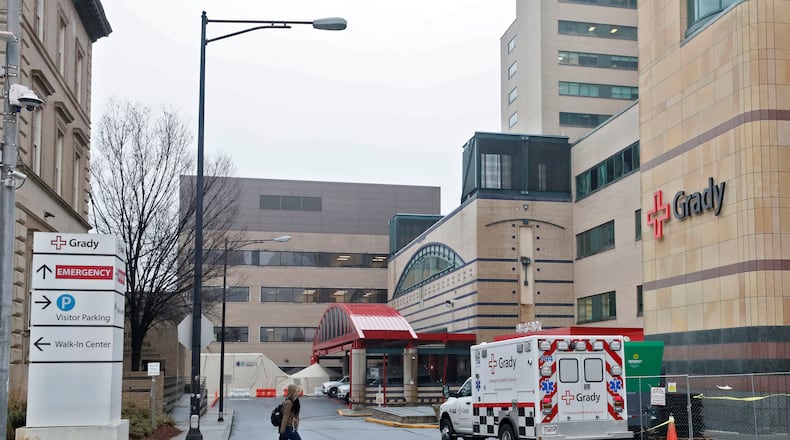When a burst pipe caused a catastrophic flood in Grady Memorial Hospital the afternoon of Dec. 7, the ambulances that deliver it 200 of the state’s most urgent cases every day were told to go elsewhere. As hours turned to days, the larger Atlanta hospital community neared the end of its rope.
This Saturday marks two weeks since the state’s biggest safety-net hospital began scattering its patients across metro Atlanta. The Georgia governor declared a state of emergency and announced a mobile emergency room would be brought from out of state to Grady.
It’s there and being assembled. Grady now has about half of its ambulance traffic back, and it is taking the most severe and disruptive cases. But Grady officials say the hospital won’t be back at full capacity for months, and the patient loads remain high in other hospitals’ emergency rooms. There is no way to count the continuing impact on other hospitals, but several say their ER traffic has not noticeably decreased — all while flu season ramps up.
In the days after the flood, other metro hospitals began reaching capacity in their own emergency rooms. One began declining ambulance patients. At least two others prepared to do the same.
Emory, Northside Hospital and Piedmont Healthcare each said their hospitals accepted about 30 patient transfers from Grady. But they said it’s hard to quantify the overall effect Grady’s diversion had on their operations, since they do not track which patients in their ERs would have gone to Grady.
“This was a very unexpected, unprecedented emergency situation,” said Ryan Loke, Gov. Brian Kemp’s adviser on health policy, who took part in some of the discussions. “When Grady shuts down for an hour people feel it. When parts will be shut down for months people certainly feel it.”
The crisis level was lowered six days later, after hospital CEOs and state and local emergency officials agreed on a radical solution. The region would stop the practice of routing ambulance calls within counties; Grady would create a metro Atlanta ambulance call center for all calls within I-285 so Grady could pick out the severe cases to begin taking those again. Grady went from full diversion of all ambulances to partial diversion, and the load on other hospitals retreated from crisis.
“Piedmont Atlanta Hospital hasn’t seen a lot of change at the inpatient level, as we likely would have been at capacity anyway,” a hospital spokeswoman said, “but we have seen increased volumes in the emergency department since Grady has been on diversion.”
Grady has still not released any information about what might have caused the 24-inch water pipe on the sixth floor to break or how much repairs might cost. The break affected at least three floors, damaging more than 200 patients’ rooms. A Grady spokeswoman said the cause is under investigation.
For one week, ambulances carrying the most severe cases from car crashes, gunshots, fires and mental illness were turned away from Grady, the only nationally verified Level I trauma center for adults in the area, and sent to other emergency rooms.
The damaged rooms held 150 patients, but not all had to be transferred. Grady transferred 57 of its own patients to other hospitals and 26 to facilities for post-hospital care. The hospital is now accepting victims of trauma, stroke and burns, as well as behavioral health patients.
State government and Grady officials who spoke to The Atlanta Journal-Constitution expressed confidence that the hospital and the community had moved quickly to stem as much damage to patients as possible.
“Every hospital only has a certain amount of beds — obviously — any given day,” said Chris Rustin, the director of the Georgia Department of Public Health’s division of health protection. “But when something like this happens unannounced, and all of a sudden now you’re seeing an extraordinarily higher percentage of patients, that’s where the system starts having issues.”
“Before, when Grady was on diversion, it really strained the system across the board,” Rustin said.
Three days after the flooding, Emory University Hospital Midtown implemented its own ambulance diversion due to the “high volume” of patients coming into its ER. A spokeswoman for Emory said the hospital has returned to regular operations but continues to treat a higher-than-normal number of patients.
Rustin said Emory Decatur Hospital and at least one other hospital went on “soft diversion,” where they made no blanket announcement to divert ambulances but began monitoring their capacity with an eye to refusing patients. Emory Healthcare said the hospital, formerly known as DeKalb Medical Center, went on full diversion briefly but not necessarily as a result of Grady.
Those hospitals that took in Grady patients did not say they’ve seen a marked decrease in their patient loads since Dec. 13, when Grady began taking some ER patients again. This is already a busy time for hospitals, with flu season beginning and patients choosing to have surgeries before the end of the year.
One of the biggest players in the diversion was the WellStar Health System, which also operates a major trauma center. The vice president for emergency services at WellStar, Freda Lyon, said WellStar Atlanta Medical Center saw a “slight increase” in the number of patients it treated. Lyon said the hospital returned to normal operations after Dec. 13, but she did not provide estimates on how many patients it saw compared with a regular day.
If the flood and the resulting pandemonium impacted patients’ health, it could show up in longer wait times: longer ambulance drives, longer waits for care in unusually loaded hospitals. Grady and the DPH were aware of no impacts from the flood on patients’ health.
Dr. John Sy, the president of the Georgia College of Emergency Physicians and president of the emergency physicians at Savannah’s Level I trauma center, said big hospitals and ambulance systems across the state operate on finely tuned margins. His hospital regularly goes on partial diversion.
“What I worry about is, whenever we are over capacity and we have a waiting room of 50 people, the reality is, all 50 at that moment, they don’t wait until they get back (to the ER care area) sometimes.
“What I worry about is there’s always a percentage that leave because they don’t want to wait anymore,” Sy said. “Some of the time they’re OK. But if there’s a sepsis or heart attack, that’s my concern.”
And there’s not much of a way to report that, he added.
Grady has not released specifics about how crews are cleaning up the mess caused by the flood. But experts and hospital officials from across the country who have been through similar situations said it is an extensive and expensive process to clean up water damage at hospitals.
After a contractor accidentally broke a quarter-inch pressurized water pipe at Houston’s Ben Taub Hospital in September, it sent water onto five floors and into 91 of the building’s 400 rooms, Vice President of Operations Jason Kunnacherry told the AJC. The hospital, which is smaller than Grady but is a Level I trauma center, placed its emergency room on diversion for three days after declaring a systemwide internal disaster. With an extra burden on the city’s other hospitals, Ben Taub felt the pressure to begin accepting patients again.
“By the second day, it was like, ‘OK, guys, we need to get back online,’ ” he said.
Grady initially said it would lift its diversion status four days after the flooding happened. Two weeks later, it is still not accepting a full patient load in its emergency room.
At Ben Taub in Houston, it took almost a month until all the damaged rooms were back open. Kunnacherry estimated the repairs cost more than $6.5 million.
“For the most part, it was wet everywhere,” Kunnacherry said, adding that crews had to cut out parts of the wall that got wet and replace the drywall to keep mold and infections from developing.
Tearing out damp walls is a typical step for hospitals that experience flooding, said Nick Hobbs, who manages mitigation and mold control for a Dallas-based company that clears water from two to three hospitals every year.
“If we’re having to contain and separate patient care from the areas that we’re working in, it can be a huge detriment for the hospital,” Hobbs said, adding that the cost for cleanup work is “definitely not cheap.”
The Latest
Featured




